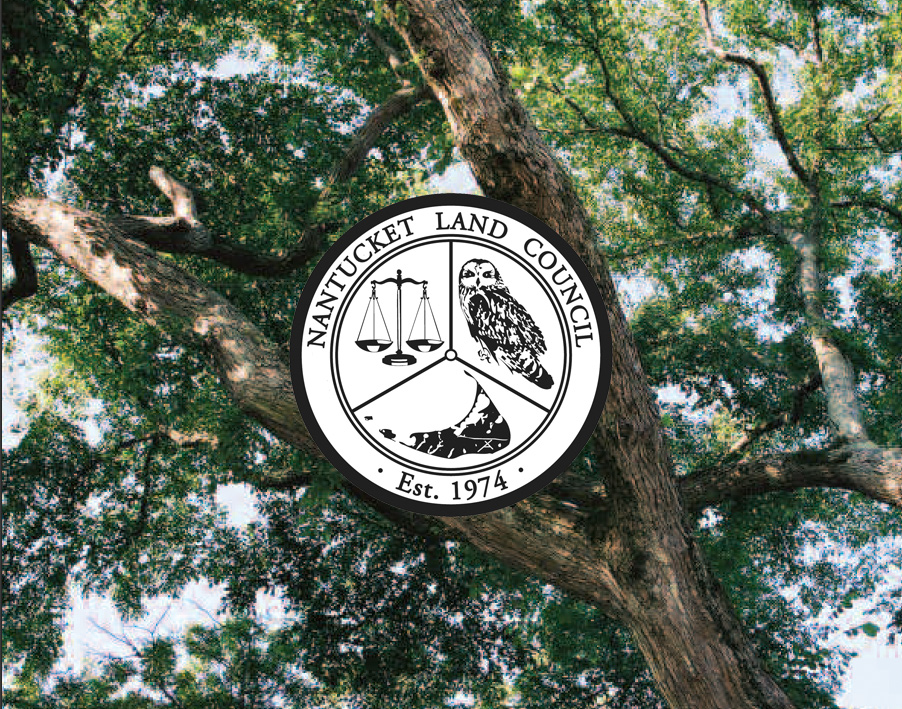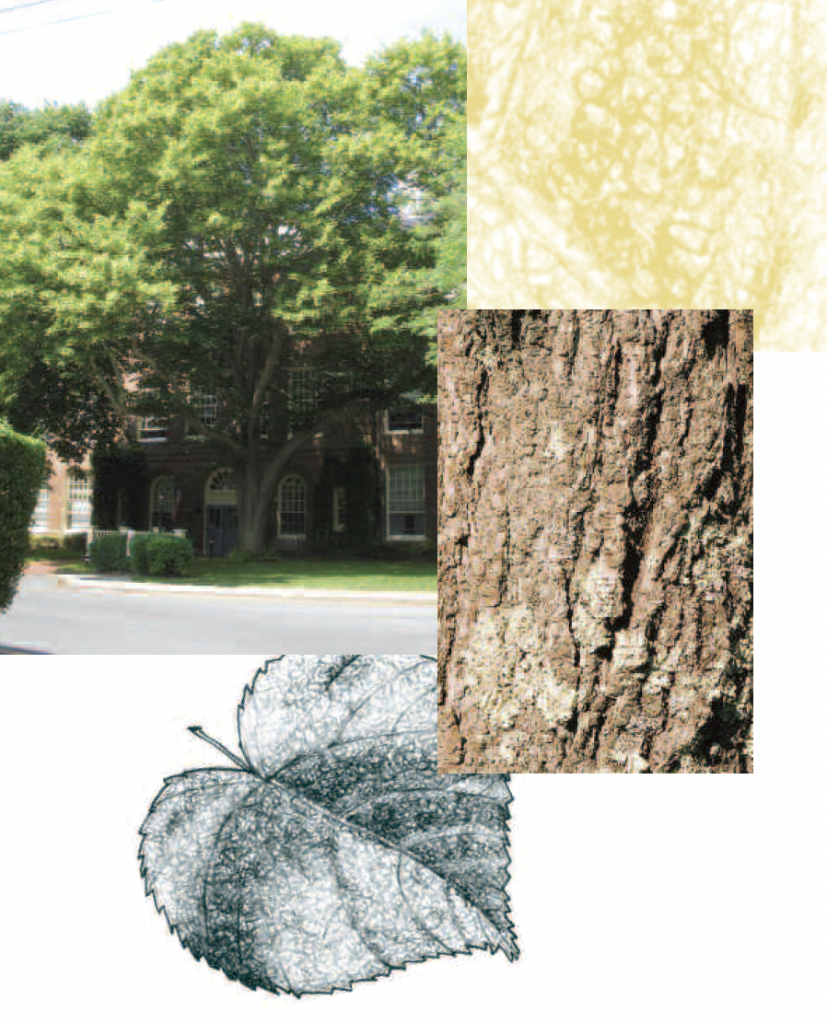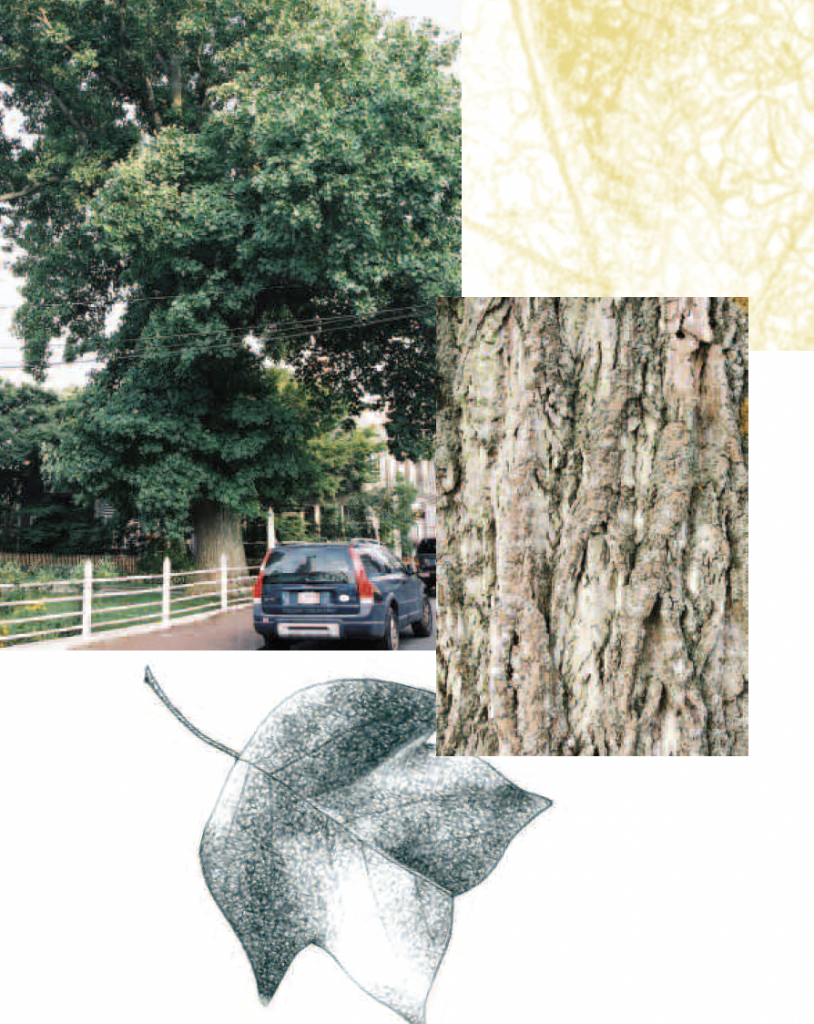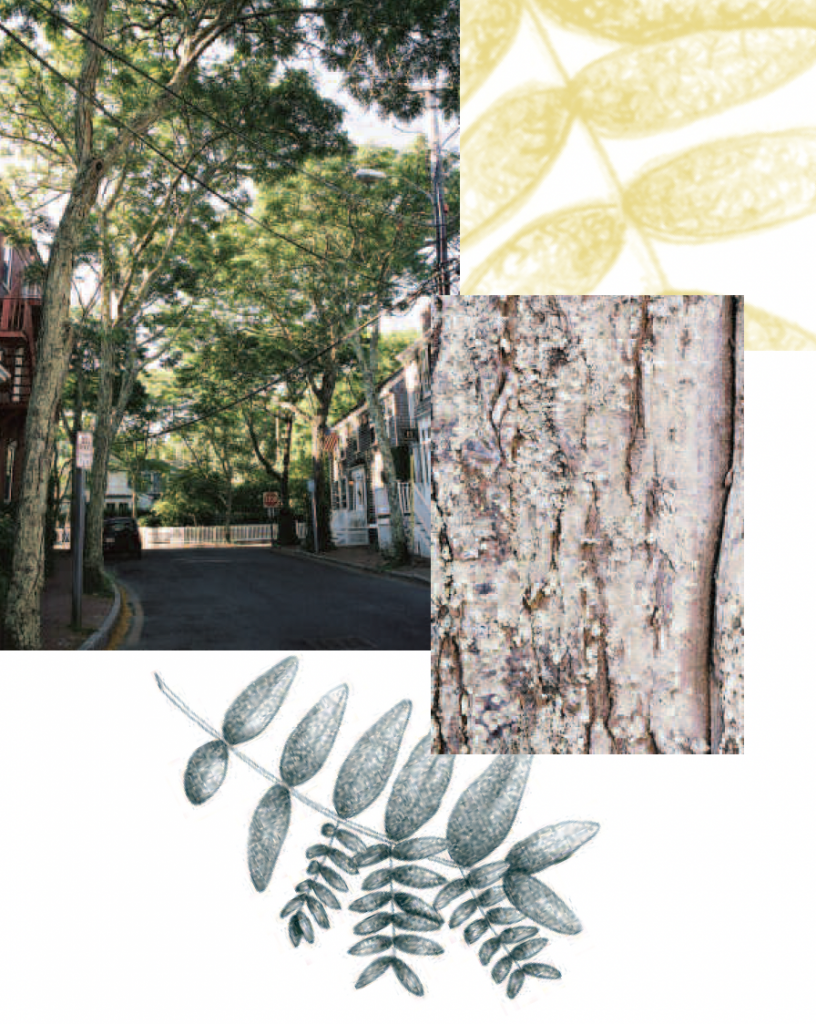This Guest blog was shared from the Nantucket Land Council and was funded in part by the Nantucket Garden Club.
NLC offers free tours of our beautiful downtown trees once per month from June through September. Most visitors learn all about the historic structures and cobblestone streets, but very few look up at the majestic giants that line our roads. Come along for a walk one summer morning to hear their stories!
Nantucket Downtown Tree Guide
The town of Nantucket is graced with a variety of magnificent trees. We have selected a few of the most majestic specimens to describe here with photos and biological information. A walking trail is also included for your enjoyment. Please take some time to have a closer look at the trees of downtown Nantucket and enjoy our self-guided tour.
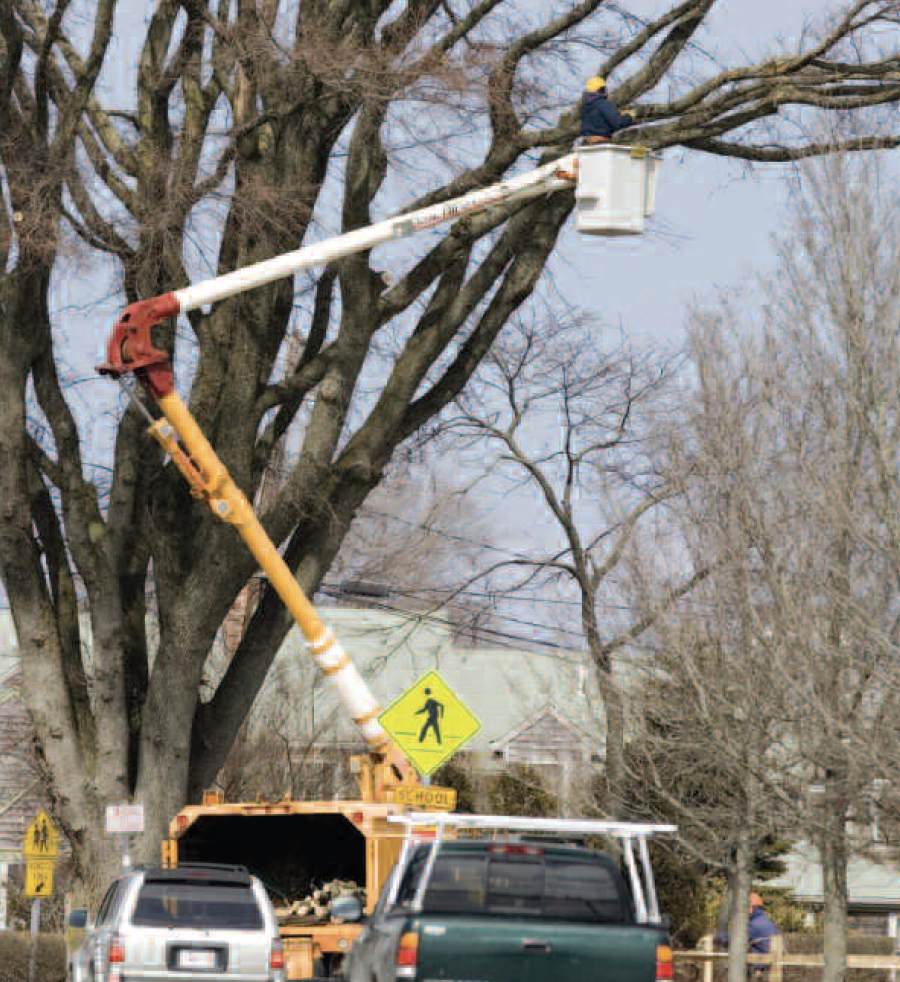
The streetscapes of downtown Nantucket offer a stark contrast to the scrub oak and huckleberry-dominated landscape that exists outside of Town. The downtown area contains a great assortment of mature, mostly ornamental trees providing habitat for birds and insects and shade for those below. For the past one hundred and fifty years, Nantucketers have been avid planters of trees, lining our streets with hundreds of specimens. Today, we are left with a legacy of stately giants that tower over our historic downtown and add a special element that should not be overlooked.
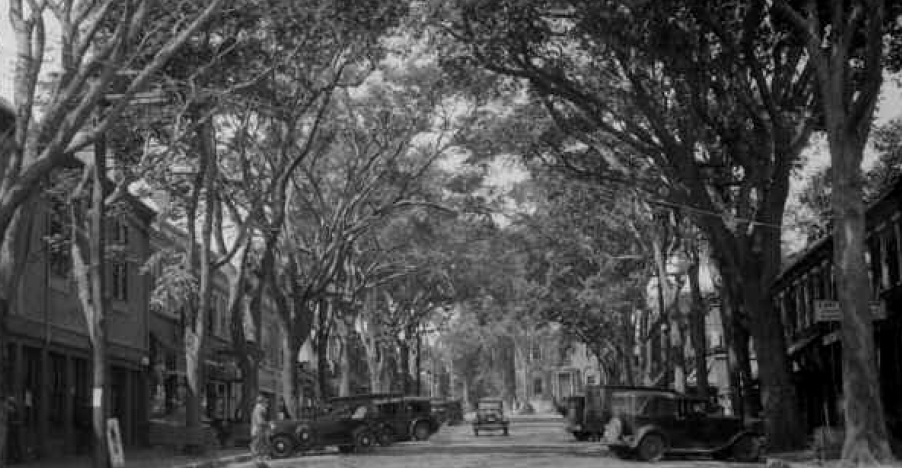
Association, P20783.
Throughout the 1900’s and still to this day, Town Meeting has appropriated money for tree planting and maintenance. Nantucket has hundreds of Town Trees; a designation that means they are cared for by the Town even if they are on private property. The Department of Public Works has two employees that pay particular full time attention to the health and well being of these important plants. While many different species dot the downtown landscape, from the American linden to the southern catalpa, one of the few species that has made a distinctive mark on Nantucket is the mighty American elm. Once the preferred sidewalk tree in the northeast, historic downtowns throughout New England were shaded with the towering trees. After the great fire of 1846 that burned most of downtown Nantucket, a new crop of American elms was planted along almost every street and at every corner. Main Street was once enveloped above by a great mass of American elm branches.
In the later half of the twentieth century, however, our global economy caught up to the American elm through the unwanted importation of the Dutch elm disease. This debilitating fungus, which is spread by the elm bark beetle, helped destroy nearly all cultivated and natural American elms throughout the Continent. Many of the Nantucket trees infected with Dutch elm disease were replaced with Buisman elms which were cultivated from a single resistant tree that was discovered in the Netherlands. The Buisman elms, however, have a more limited tolerance to sea winds and have not matured into the same stately trees that they replaced. Luckily, due to our remote location, many of the Nantucket elms have withstood the devastating effects of the disease. Careful disease prevention and pruning strategies employed by the Town have also helped promote the elms’ survival. Only a handful of communities across the country are lucky enough to enjoy some of the original American elms, with some of the finest examples being on Nantucket.
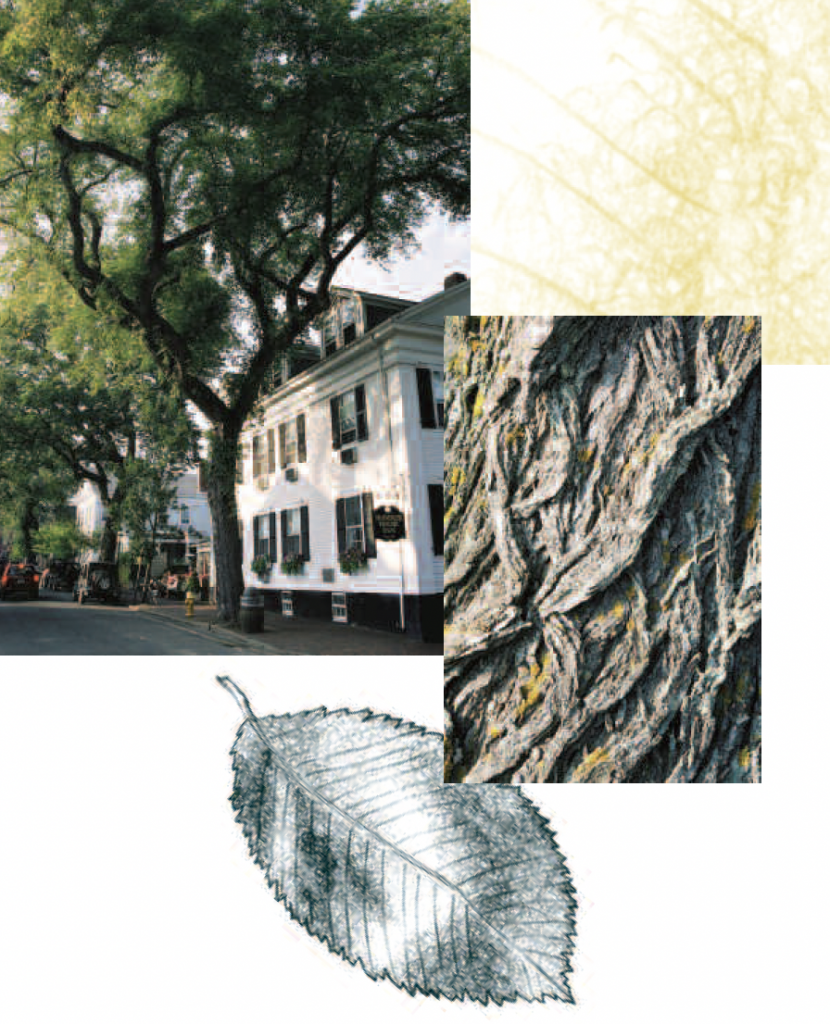
ELM
American Elm, Ulmus americana
Height: 80-100’ (up to 125’)
Diameter: 2-5’ (up to 10’)
Leaves: 3-6” long and 1-3” wide
Elliptical, doubly saw toothed, bright yellow in autumn.
Bark: Light gray and deeply furrowed.
Flowers: 1/8” wide
Greenish colored clusters—Early spring.
Range: SE Saskatchewan east to Cape Breton Island south to Florida and west to central Texas.
Habitat: Moist soils, mixed hardwood forests.
LINDEN
American Linden, Tilia americana
Height: 60-100’ (up to 125’)
Diameter: 2-3’ (up to 4’)
Leaves: 3-6” long and 3-4”wide
Broad, heart-shaped and pointed at the tip, coarsely saw
toothed, pale yellow or brown in autumn.
Bark: Dark gray, mostly smooth but may become grooved.
Flowers: 1/2 -5/8” wide
Yellowish white clusters hang from greenish bract—Early summer.
Range: SE Manitoba east to SW New Brunswick and Maine south to W North Carolina and west to NE
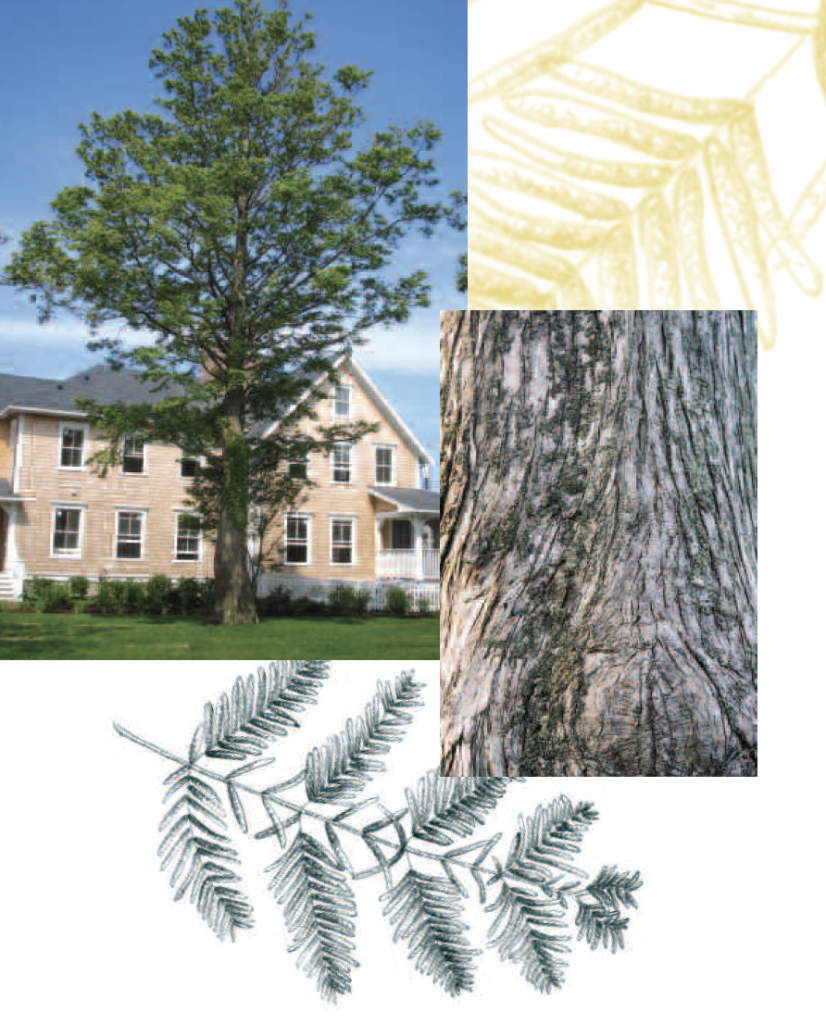
REDWOOD
Dawn Redwood, Metasequoia glyptostroboides
Height: 70-120’ (up to 150’)
Diameter: up to 6.5’
Leaves: 1/2” long
Deciduous, flat, opposite leaves, bright green, turning red-brown in the autumn.
Bark: Reddish-brown and fissured, sometimes becoming shaggy.
Cones: 3/4 -1” long and wide, dark brown
Range: Native of central China. Introduced to the US in 1947-1948. This species is thought to be over 50 million
years old, often referred to as a “living fossil”.
Habitat: Wet soils with good drainage, full sun.
SYCAMORE
American Sycamore, Platanus occidentalis
Height: 50-130’ (up to 175’)
Diameter: 3-8’ (up to 14’)
Leaves: 4-10” long and wide 3 or 5 toothed lobes, turning brown in autumn.
Bark: Smooth and mottled, peeling/flaking off to expose varying shades of brown, gray and green.
Flowers: Small greenish drooping clusters, maturing to 1” diameter hanging ball-shaped fruit—Spring.
Range: SW Maine south to NW Florida west to S central Texas north to E Nebraska. Also NE Mexico.
Habitat: Wet soils, mixed forests.
SILVER MAPLE
Silver Maple, Acer saccharinum
Height: 50-80’ (up to 120’)
Diameter: 1-3’ (up to 5’)
Leaves: 2-10” long
Deeply 5-lobed, silvery white on bottom, turning pale yellow to orange in autumn.
Bark: Gray, long slender ridges, sometimes becoming shaggy.
Flowers: 1/4” wide
Short clusters, reddish to greenish yellow—Early spring.
Range: S Ontario east to New Brunswick south to NW Florida west to E Oklahoma north to N Minnesota.
Habitat: Wet soils in floodplains with other hardwoods.
YELLOW POPLAR
Yellow Poplar/Tuliptree, Liriodendron tulipifera
Height: 50-120’ (up to 190’)
Diameter: 2-6’ (up to 10’)
Leaves: 3-10” long and wide
Boxy, broad at base and tip with 4 or 6 lobes, turning yellow in autumn.
Bark: Gray, thick and deeply furrowed.
Flowers: 1 1/2-2” long and wide
Orange and green, tuliplike, upright at end of leaf twig— Spring.
Range: S Ontario east to Vermont and Rhode Island.
Habitat: Well drained soils
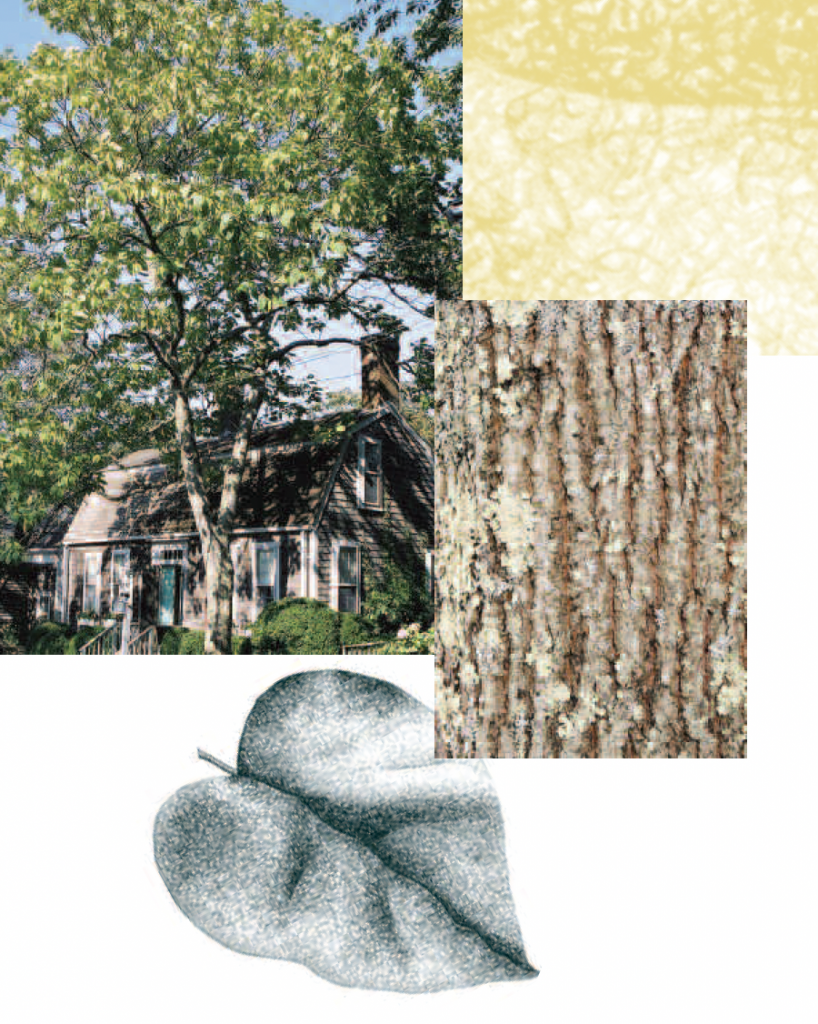
CATALPA
Southern Catalpa, Catalpa bignonioides
Height: 40-50’
Diamter: 2-4’
Leaves: 5-10” long
Long and broad, pointed at tip, turning blackish
in autumn.
Bark: Brownish-gray and scaly.
Flowers: 1-2” long
White and bell-shaped with purple spots—Late spring.
Range: Widely naturalized from S New England south to Florida west to Texas and north to Michigan.
Habitat: Moist soils in clearings.
LOCUST
Honeylocust, Gleditsia triacanthos
Height: 80’
Diameter: 2 1/2’
Leaves: 4-8” long consisting of many oblong paired leaflets, may be pinnate or bipinnate (as shown in sketch), shiny green, turning yellow in autumn.
Bark: Gray-brown and fissured, sometimes with scaly
ridges. Native grown trees have modified branches that are stout brown spines.
Flowers: 3/8” wide, greenish-yellow narrow clusters
Range: S. Ontario to central Pennsylvania, south to NW Florida, west to SE Texas and north to SE South Dakota.
Habitat: Moist soils in mixed forests, dry uplands or waste places.
DOWNTOWN TREE MAP
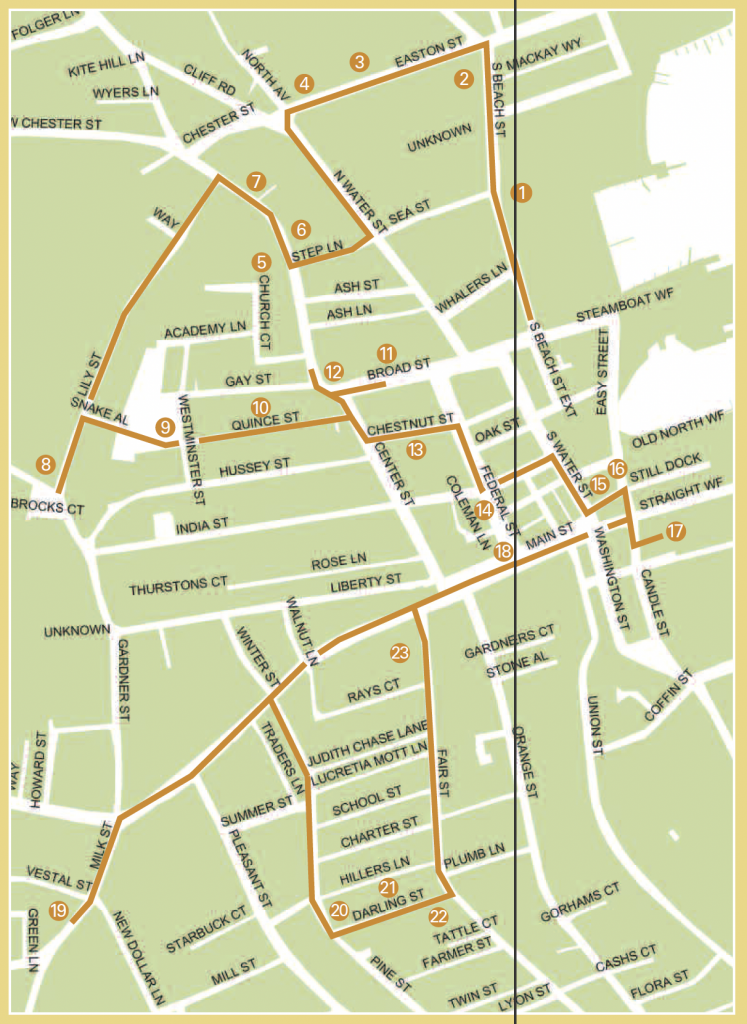
WALKING GUIDE
This walking tour highlights both Town trees and trees that are privately owned. Please respect the privacy of individual property owners and enjoy the trees from the sidewalk.
You can enjoy all of the guided walk at once or one portion at a time. Also keep in mind that there are many other side streets with unique trees that are not explored here. We encourage you to use this brochure as a guide and to venture into additional areas to do some exploring of your own.
Although you can begin the walking trail at any point along the way, we recommend starting at the corner of Broad and South Beach Streets next to the Whaling Museum.
Walking north on South Beach Street (1) towards Children’s Beach you will notice American sycamore trees (see detail) lining both sides of the street. After passing Children’s Beach, Harbor View Way, on the right, you will find a dawn redwood tree (see detail) on the left side of the street (2). The dawn redwood is known as a “living fossil”. It was discovered in China in 1944. Prior to this discovery it had only been described as a fossil from the Mesozoic Era.
Turn left onto Easton Street and you will see an American linden (see detail) directly at the corner on the left. As you travel down Easton Street you should notice two giant trees on the right (3). The first of these is an American linden and the second is an American elm (see detail). Despite the widening of Easton Street in the recent past, great care has been taken to preserve these specimens in the sidewalk.
Turn left onto North Water Street and stop to look across to the American elm at the corner of Cliff Road and Easton Street (4). You will find more elms and lindens on both sides of North Water Street. Make your first right onto Steps Lane and head up the hill to Center Street. Cross over into the churchyard (5) where you will find a mixture of sycamore maples and Norway maples, which are both considered to be invasive species when planted near natural areas, and also a southern catalpa (see detail). The catalpa is at the back left corner of the yard and can be identified by its giant heart shaped leaf. Proceed back to Center Street and turn left out of the churchyard. Approximately 40 yards away you will find a yellow poplar tree (see detail), also known as a tulip tree, on the right hand side (6). This tree also has a distinctive leaf with four lobes. Further down the street in front of #59 there is an old white willow with an amazing trunk system that shouldn’t be missed (7).
Make the next left onto Lily Street. You will pass a cluster of holly trees on the right, likely a combination of English holly and American holly. Travel down to the junction with North Liberty Street. This tree may be a little out of the way but it is one of the finest specimens of American elm on the island (8) and on the opposite side of the road you will see an amazing black walnut tree.
Turning around and heading back down Lily Street you will turn right after # 11 to walk up the steps behind Academy Hill. Once at the top of the stairs, take a few moments to look around and enjoy another stunning selection of American elms (9). Moving around to the front of the old Academy Hill School you will find another American linden, this one with a huge spreading crown. Standing with the School on your right, turn left at the next intersection onto Quince Street. Take Quince all the way down to Center Street. Along the way you will see a beautiful American elm on the left and another great example of a southern catalpa towards the end of the street on the right (10).
Turn left onto Center Street and when you reach Broad Street turn right to appreciate another one of the largest American elms on the island (11). This massive tree leans over the street spreading into a spectacular canopy above. The Town’s tree maintenance crew has spent much time caring for and pruning this tree over the years, as is evidenced by the support cables visible way up in its branches. Turn around to head back up to Center Street, and walk to the right around the Jared Coffin House and into the dappled sunlight of a honey locust grove (see detail) (12). Once you are finished admiring these trees, turn around and head back along Center Street where more giant elms provide a peaceful shade for the street below.
Make your first left onto Chestnut Street where you will see a small chestnut tree on the left and an American linden on the right (13). As you turn right onto Federal Street take a moment to notice an American sycamore on your left. Federal Street along with some of the surrounding downtown streets boasts a collection of the most stately and oldest elms around. Most of these elders were planted around 1850 after the great fire (14).
Make a left onto India Street and as you pass the Atheneum you may want to spend a minute or two in its gardens to appreciate among others, three more honey locusts. At the end of India Street you will turn right onto South Water Street, walk past Cambridge Street and find an American elm followed by a yellowwood on the left at the corner of the next cross street (15).
Make a left at this intersection onto Still Dock Street before reaching the three story brick building. At the end of this block-long street, look for two English oaks (16) on your left.
Turning right you will walk down Easy Street and make a left at the bottom of Main Street. Enter the large parking lot and here you will find a combination of honey locusts and American sycamores. Take the time to wander to the very center of the lot to see the biggest of these sycamores (17). Head back up Main Street and enjoy a variety of American elms, sweet gums with star shaped leaves and oaks. Carry on past the bank and you will find upper Main Street lined with more massive American elms and American linden trees (18).
For a short side trip, continue on to the monument and turn left onto Milk Street passing a few grand elms on the right. Walk just a bit further past Vestal Street and on the right is a gorgeous and huge American sycamore (19). This is an example of how they can grow with the right light and space and without the salt spray that can come off of the harbor during rough weather. Walk back down Main Street past Pleasant Street and turn right onto Pine Street. See if you can identify the catalpa on the left as you proceed down to Darling Street.
Turn left onto Darling Street, the first left after Hillers Lane, past the maple and elm trees at the corner (20). Down Darling Street on the left is a very large white ash and a stunning honey locust tree that tower above (21). At the end of the street you won’t miss the silver maple tree (see detail) in a yard on the right (22). Turn left onto Fair Street and head back towards town. Our last tree lives across from #8 Fair Street (23). This noble white ash is a perfect addition to the street and its genus is rarely seen throughout the island neighborhoods.
We hope you have enjoyed the tour and have been able to fully appreciate the street trees that turn our city landscape into a place of character and history. Visit NantucketLandCouncil.org for more information.
Click here to download the guide for The Trees of Downtown Nantucket.

